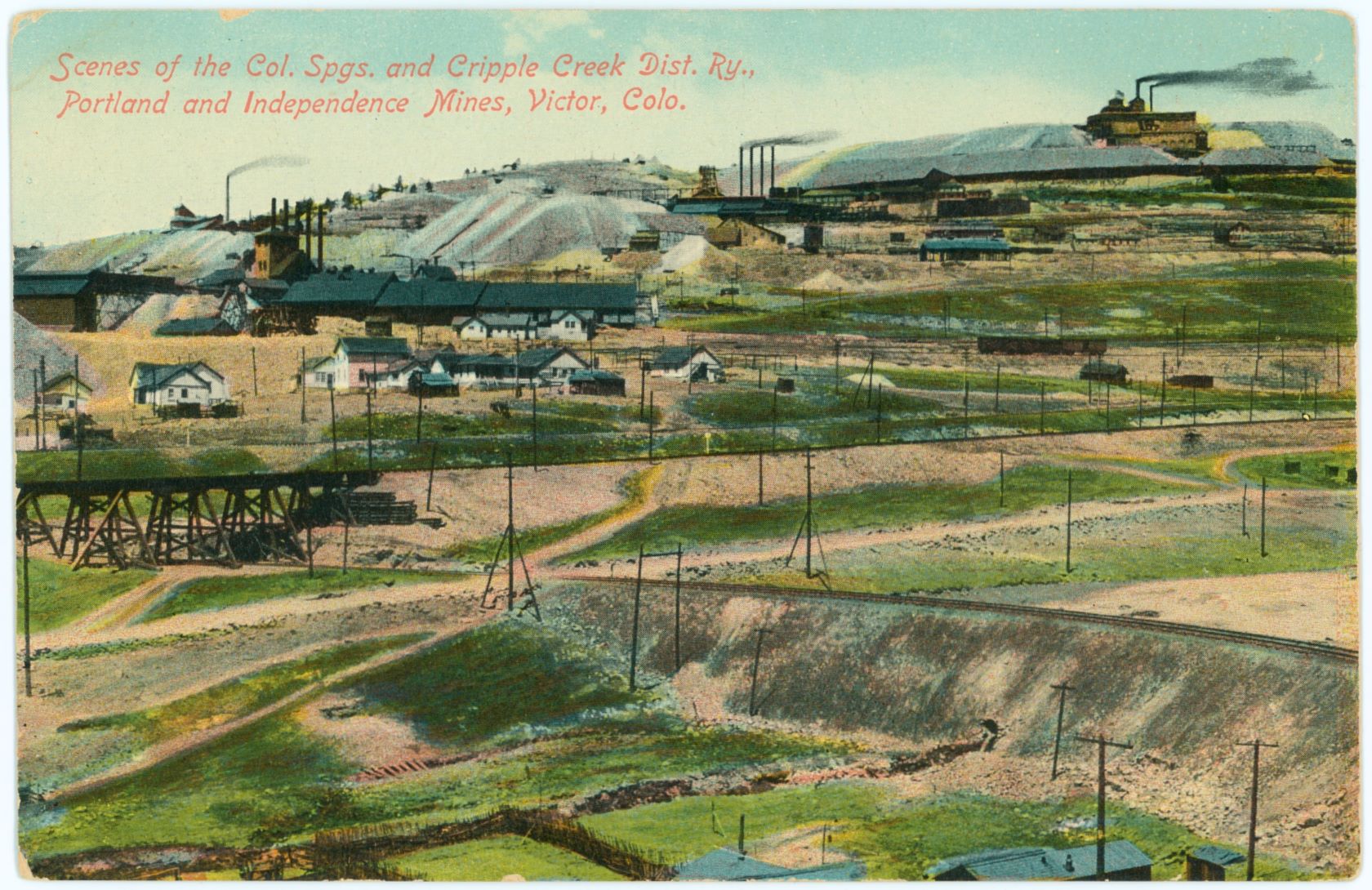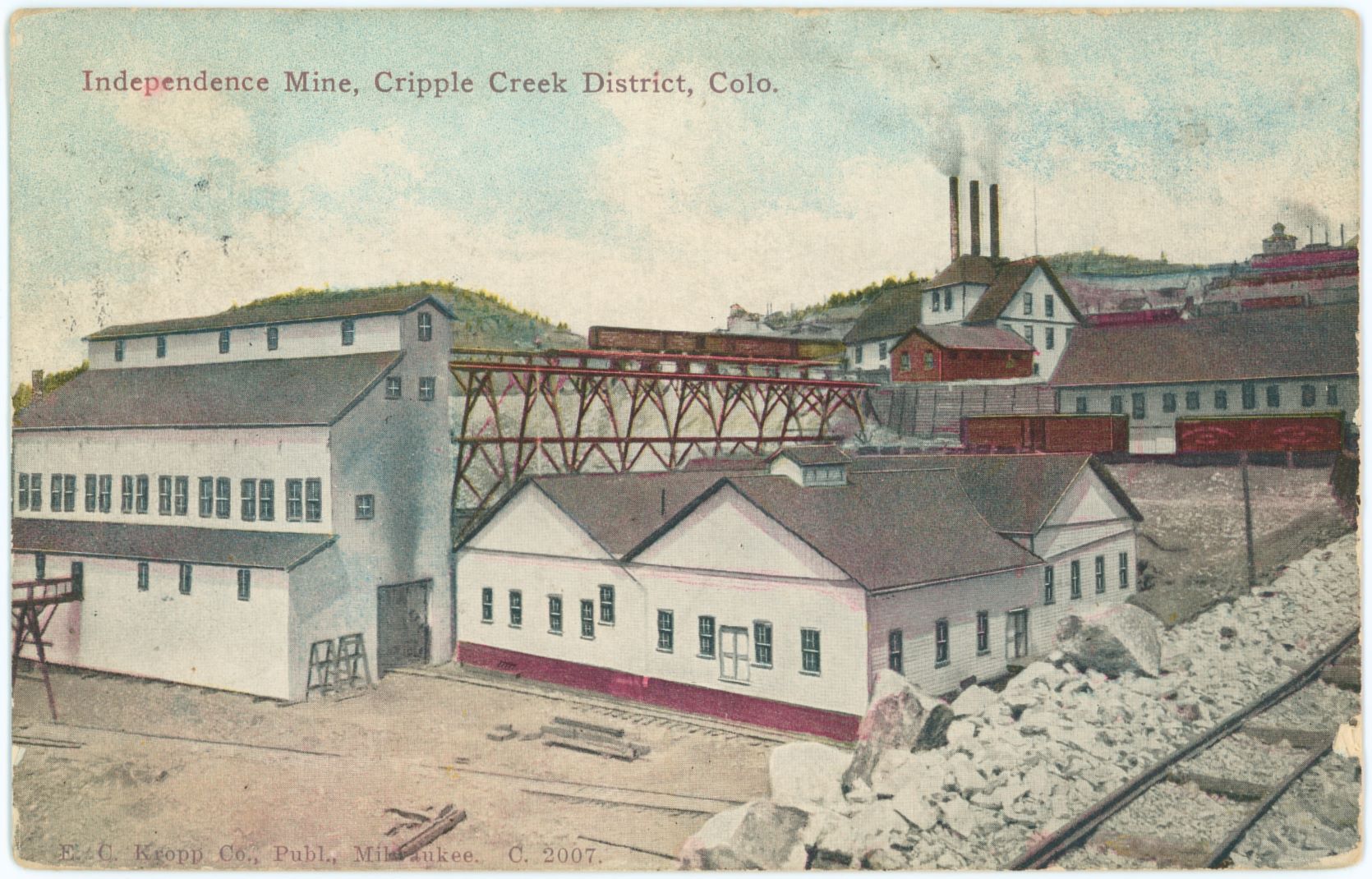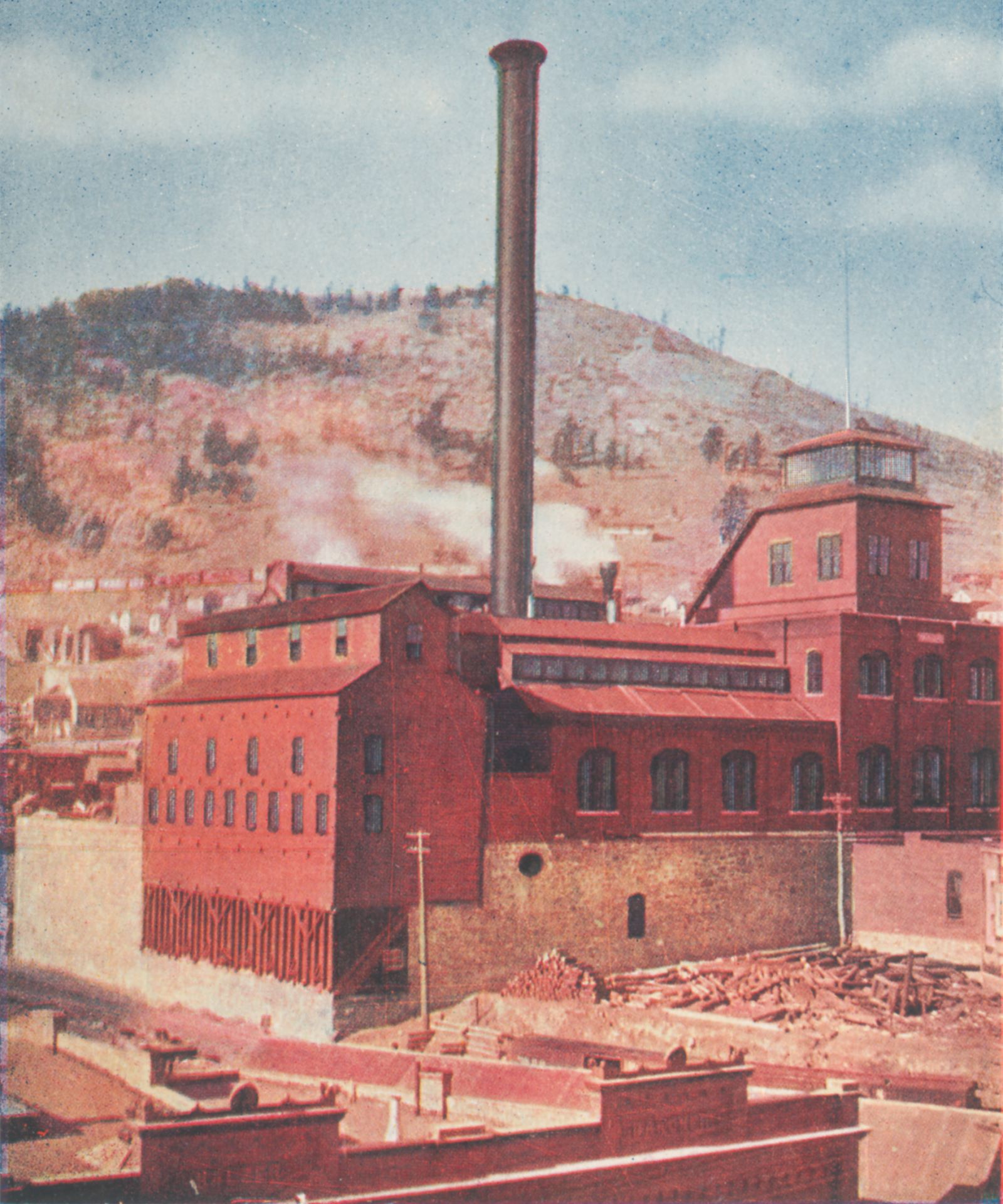-> HathiTrust Digital Library Site; Link to First Page.
Source had no pics, so I used pics from my collection
| Year. | Gold. | Silver. | Copper. | Total. | |||
| Quantity. | Value. | Quantity. | Value. | Quantity. | Value. | ||
| Fine ozs. | Fine ozs. | Pounds. | |||||
| 1905 | 745,542.17 | $ 15,411,724 | 49,449 | $ 29,867 | $ 15,441,591 | ||
| 1906 | 689,500.73 | 14,253,245 | 49,527 | 33,183 | 1,280 | $ 247 | 14,286,675 |
| Increase (+) or decrease (-) | - 56,041.44 | - $ 1,158,479 | + 78 | + $ 3,316 | + 1,280 | + $ 247 | - $ 1,154,916 |
The total value of the metallic production from the Cripple Creek district in 1906 was less by $1,154,916 than in 1905.
The gold amounted to $14,253,245, a decrease of $1,158,479, and the silver to 49,527 fine ounces, valued at $33,183, an increase in quantity of 78 ounces and in value of $3,316.
In 1906, 1,280 pounds of copper were reported. One hundred and five mines made a total production of 702,069 short tons of ore which averaged $20.35 to the ton, as against 88 mines, 716,358 tons, and $21.56 per ton in 1905.
This total included a relatively small amount of gold and silver recovered from old tailings by the larger mills handling Cripple Creek ores.
These figures do not necessarily represent the values which reached the market as bullion in 1906, but the amount of values in the ores extracted from the mines of Teller County and either reduced or disposed of by sale during 1906.
Therefore, any stock of 1906 ores held over by the smelters or mills to be reduced in 1907 would cause a smelter report to show the actual bullion produced to be less than the production shown in a mines report.
Ordinarily this discrepancy tends to balance itself from year to year, but toward the end or 1906 a very considerable quantity of ore which was not milled till 1907 was awaiting the completion of several plants.
The total decrease of $1,154,916 was wholly caused by a falling off of $2,429,764 in the combined production of 4 of the largest mines. Therefore, excluding these 4 mines, there was a gain of $1,304,848 in production from the other mines of the district.
Other than a small production reported from the Copper Mountain section, the entire output was derived from the Cripple Creek district proper. The history and technology of the gold deposits, as well as the geology and mineralogy of the district, including detailed descriptions of the mines, can be found in a recently published report of the Geological Survey*1.
The production was affected in a measure by the misfortunes which overtook some of the companies during 1906;
Early in May a fire destroyed the shaft house, engine room, boiler shop, and blacksmith shop at shaft No. 1 of the Portland Company
And in driving a drift on the 1,000-foot level of the El Paso Company's mine a heavy flow of water was struck which filled the workings to the level of the El Paso tunnel.
The Dorcas mill, at Florence, was destroyed by fire early in the year
And there was a delay in the completion of the new reduction plant of the Golden Cycle Company.
Throughout the year harmony existed between miner and operator. The leasing system was rather generally in vogue, and only a few large mines, including the Portland, the Strong, and the Cresson, were operated entirely on company account.
The question of drainage remained a serious problem in 1906 and led to the organization of the Cripple Creek Drainage and Tunnel Company and the pledging of sufficient funds to complete the long bore.
The intermediate tunnel plans were adopted, and work began on May 11, 1907. The adit was started in Gatch Park, at an elevation of 8,020 feet, or 723 feet lower than the El Paso tunnel, the lowest present drainage adit.
It is expected that it will take two years to reach the present main water course, 15,550 feet from the portal then the tunnel will be driven forward to the Vindicator shaft, a total length of 27,190 feet, equivalent to 5 miles and 790 feet.
Considerable interest relative to the question of milling the lower grade ores was manifested during 1906. Not only have several attempts been made from time to time to operate small mills at a profit about the district, but the year 1906 found a number of the largest companies attacking the problem.
The foremost new mill enterprise was the Golden Cycle's 700-ton roasting and cyanide plant, at Colorado City, in which the refractory ore was roasted in 100-ton furnaces. Unforeseen difficulties postponed the starting of this big plant till toward the end of February, 1907, and later (July) it was destroyed by fire.
This will affect the production of the district for 1907.
The Portland Mining Company erected a 300-ton cyanide plant at Colorado City to treat the tailings from their chlorination plant, and have been carrying on experimental work to discover the most suitable cyanide method to replace their present chlorination mill.
A very small quantity of custom ore, from mines other than the Portland, was treated in 1906, but more oxidized ore will be purchased from time to time to mix with the more refractory ores of the Portland mine.
The large chlorination and cyanide mill of the Dorcas Mining, Milling, and Developing Company, at Florence, was destroyed by fire in March, 1906. This was a custom mill, treating Cripple Creek ores.
The Economic chlorination mill, at Victor, was operated a portion of the year, but closed down, and was burned early in 1907.
The Jo Dandy Company purchased the old cyanide mill of the Cripple Creek Cyanide Company, at Gillett, which they dismantled, moved to Raven Hill, and remodeled into a 250-ton modern plant.
McDougal roasters were installed.
There was also some activity among the smaller nonroasting cyanide plants in the district.
The Isabella Mines Company erected a 300-ton cyanide mill during 1906 to treat the lower grade ores from their properties as well as from the dump, but the plant was only run experimentally in 1906.
Two small mills on Squaw Mountain - the Home Run, of 25 tons capacity, and the Santa Rita - were run at intervals during the year.
The Dexter and Sioux Falls plants were idle, and the Los Angeles mill was destroyed by fire.
Work was resumed in the small 100-ton mill of the Cripple Creek Homestake Company by the Ironclad Milling Company. The larger mill of the former company was closed.
A 50-ton cyanide mill was operated on the El Paso dump.
The Little Giant mill was rebuilt, in Pony Gulch, 3 miles south of Cripple Creek.
The Wishbone Milling Company also erected a small new cyanide mill on Spring Creek, and began operations in the spring of 1907.
The Blue Flag Company's new mill was also started in 1907.
During 1906 the Vindicator Company erected a testing mill in the Old Lillie shaft house at Independence, and made extensive tests preparatory to erecting a large plant.
Tests extending over a long period on ore from the Independence dump led this company to decide to erect a large cyanide plant at their mine, above Victor, during 1907.
According to the printed annual report of the company, the great Portland mine, the banner producer of the camp, made a total output of 103,614 short tons of ore, valued at $1,932,083.
This represents a decrease of 5,619 tons and nearly half a million of dollars in value as compared with 1905. This is accounted for by the closing of shaft No. 1 for 40 days by a fire on May 6, which destroyed the surface equipment about the shaft.
The average total value per ton was lowered by the company's shipping 11,348 tons of low-grade oxidized ore for fluxing purposes at the mill. The grand total production from this famous mine from April 1, 1894, to December 31, 1906, amounted to 775,110 short tons, with a gross value of $25,034,411; it netted $7,147,080 in dividends.
With two years of high-grade ore reserves in sight, exclusive of low-grade rock, the outlook for an increased production in 1907 is very bright. Total development work includes 71,950 feet of drifts, 99,832 feet of crosscuts, 10,843 feet of raises, 4,314 feet of winzes, and 11,513 feet of sinking, the aggregate being 37 miles and 3,092 feet of workings.
The Golden Cycle mine continued its heavy shipments. A 1,200-foot shaft opens the main workings. During 1906 this company completed a 700-ton cyanide mill at Colorado City for the treatment of custom ores as well as the product of their own holdings.
The Vindicator Company's annual report reveals a successful year, regardless of the fact that the Hull City shaft was practically idle for a month, pending repairs to the shaft and hoisting engines.
The production amounted to 27,396 short tons, with a gross value of $935,614. This represents an increase of about 3,300 tons and of $42,489. The ore averaged about $34 per ton.
This mine is to be the terminal end of the great drainage tunnel, but 200,000,000 gallons of water were pumped during 1906. The holdings of the company are opened by 18 shafts, two of which are 1,200 feet deep.
The development to January, 1907, aggregated a little over 23.25 miles.
The Independence mine, of the Stratton's Independence (Limited), made a greatly reduced production, which amounted to only $956,479, but the grade of the ore remained very high, better than $41 to the ton.
The mine is opened by a shaft 1,400 feet in depth, but only the upper levels are worked. The property is operated largely by lessees, with a small amount of company work.
Experiments were begun to ascertain the best way of working the great dump of low grade ore on the property.
The El Paso Consolidated Company's exploitation work on the 1,000-foot levels was bringing most gratifying results when on March 26 a heavy flow of water was encountered, and in less than 4 hours the mine was flooded to the 600-foot level, where the water flows out of the El Paso tunnel.
For the remainder of the year mining and developing were necessarily confined to ground above the tunnel level. Nevertheless a good production was made for the year, amounting to more than 22,000 tons (in the 11 months covered by the company's annual report), valued at $801,447.
This property will be one of the first to be drained by the new tunnel.
The annual report of the Findley Consolidated Mining Company shows a greatly decreased output, amounting only to 5,220 short tons of ore, containing $115,837 in gold values, less than one-fourth of the total for 1905.
This resulted from the company spending the year in development work until the new mill of the Golden Cycle Company, at Colorado City, should be completed.
In an endeavor to facilitate the handling of lower grades of ore, this company combined with the Vindicator Company in experimental work during the year, seeking to determine a process to be used in a large mill to be built jointly by the two companies.
The Granite Gold Mining Company absorbed the Dillon Gold Mining Company, as it had previously done with the Gold Coin and Monument companies. This gives the Granite Company a large holding on Battle Mountain and makes it one of the most important concerns of the entire district.
An increased total production was made by lessees from the various holdings of the Stratton Estate, and the Strong mine also made a larger output.
The Elkton Company, as in the case of the El Paso, have limited their operations to the reserves above the present water level to save pumping costs till the new tunnel shall care for the large quantities of water.
A somewhat decreased tonnage was shipped during 1906, but there was an increase in average value of the ore.
The Work Mining and Milling Company reports a greatly increased output from the Morning Glory and the Little Clara mines, which are worked by seven sets of lessees.
Large gains in production were made in each of the following mines:
- The Cresson, of the Bull Hill Mining and Development Company
- the Mary McKinney
- the Forest Queen
- the Isabella
- the Ophir
- the Pointer
- the Anchoria-Leland
- and the Doctor Jack Pot.
Other prominent producers of 1906 include;
- the Ajax
- the Gold Sovereign
- the Gold Dollar
- the Jo Dandy
- and the United Gold mines.
The latter are now under the same general management as the Golden Cycle properties.
Development on the Ajax includes a 1,230-foot vertical shaft, 600 feet of tunneling, and between 7 and 8 miles of drifts.
A small quantity of ore was taken from the Modoc mine during one of the regular shipments, which carried a low percentage or copper.
The following table gives the production of the Cripple Creek district from 1891 to 1906:
| Year. | Gold. | Silver. Fine ounces. |
|---|---|---|
| 1891 | $ 449 | |
| 1892 | $ 583,010 | |
| 1893 | $ 2,010,367 | 5,019 |
| 1894 | $ 2,908,702 | 25,900 |
| 1895 | $ 6,879,137 | 70,448 |
| 1896 | $ 7,512,911 | 60,864 |
| 1897 | $ 10,139,709 | 57,297 |
| 1898 | $ 13,507,244 | 68,195 |
| 1899 | $ 15,658,254 | 82,520 |
| 1900 | $ 18,073,539 | 80,166 |
| 1901 | $ 17,261,579 | 90,884 |
| 1902 | $ 16,912,783 | 62,690 |
| 1903 | $ 12,967,338 | 42,210 |
| 1904 | $ 14,504,350 | 66,638 |
| 1905 | $ 15,411,724 | 49,449 |
| 1906 | $ 14,253,245 | 49,527 |
| Total | $ 168,584,331 | 811,807 |
*1 Lindgren, Waldemar and Ransome, F.L. Geology and Gold Deposits of Cripple Creek District; Profesional Paper U. S. Geological Survey No. 54, 1906
*2 Figures for 1891-1903 from reports of the Director of the Mint; figures for 1904,1905, and 1906 from reports of the United States Geological Survey.


